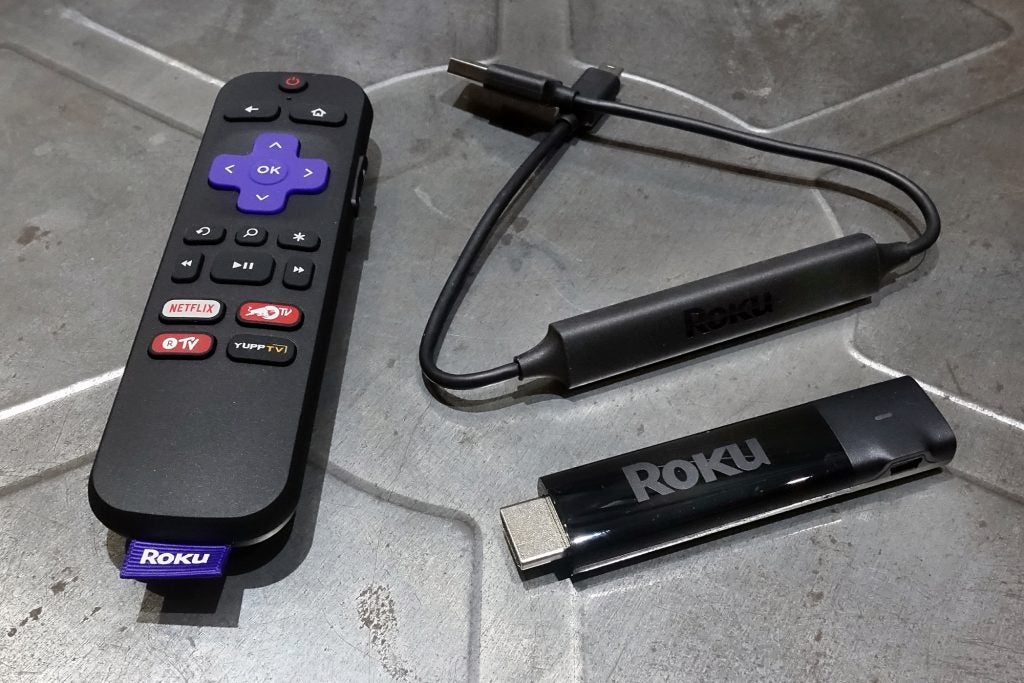Discover Pandipedia
Pandipedia is the world's first encyclopaedia of machine generated content approved by humans. You can contribute by simply searching and clicking/tapping on "Add To Pandipedia" in the answer you like. Learn More
Expand the world's knowledge as you search and help others. Go you!

Roku Streaming Stick 4K
The best overall streaming device due to its excellent performance, broad app support, and user-friendly interface, often appreciated for its simplicity and speed[5].

Amazon Fire TV Stick 4K Max
A top choice for Amazon Prime users, it offers high-definition streaming with support for Alexa voice control and a user-friendly interface[2][4][7].
Apple TV 4K
Recommended for Apple users, boasting integration with the Apple ecosystem and a seamless user interface. It supports a variety of streaming services and features high-quality video[4][7].
Google TV Streamer
Offers a powerful platform with a sleek interface, excellent for casting and controlling smart home devices alongside high-definition streaming[4][5].
Roku Ultra
Known for advanced features including Ethernet connectivity and extensive media options, making it a solid choice for those seeking a more premium experience[5][7].

Amazon Fire TV Cube
Combines streaming functionalities with Alexa voice assistant capabilities, enabling hands-free control of your entertainment setup[3][4][7].
Nvidia Shield TV Pro
Ideal for high-end users who seek great performance, 4K HDR streaming, and gaming capabilities, acting as an advanced Android TV device[3][7].

Roku Express 4K
A budget-friendly option that still supports 4K streaming, providing users with a solid attempt at high-quality content without breaking the bank[3][6].

Chromecast with Google TV
A versatile device for users who prefer casting content from their devices, complete with an intuitive interface and search functionality[3][5][7].

Amazon Fire TV Stick Lite
An economical choice for those who want to quickly boost streaming capabilities without 4K resolution, still featuring Alexa support[3][7].

Roku Streambar
Functions as both a streaming device and a soundbar, ideal for enhancing audio while providing access to a wide range of streaming services[3][6].
Apple TV (3rd Generation)
An updated model that excels in integrating streaming services and offers a high-quality interface for Apple users[5].

Roku Streaming Stick 4K Plus
Comes with an enhanced remote that supports voice commands and offers a similar experience to the original Streaming Stick 4K[4][5].

Tivo Stream 4K
A unique player that integrates with live TV services and offers a different interface for content recommendations[4][7].
Fire TV Stick (3rd Generation)
Offers HD streaming and essential features for users looking for an affordable option without 4K support[3].

Roku Express
A simple and cost-effective device for those not needing 4K, providing a wide range of channels and easy navigation[3][5].

Onn 4K Google TV Streaming Box
A surprisingly well-performing budget option featuring 4K streaming at an accessible price point[4].
Amazon Fire TV Stick HD
A more affordable option with 1080p streaming, offering a good selection of channels for casual viewers[4].
Google Chromecast with Google TV HD
Designed for those who want to upgrade older TVs to smart capabilities at an economical price[4].
Roku Streaming Stick Plus
An evolution of the original stick, it offers a reliable performance and is noted for its ease of use and expansive app selection[5][6].

Amazon Fire TV Stick 4K (2nd Generation)
A strong performer ideal for users who want high-quality streaming and integration with Amazon services[2][3].
Nvidia Shield TV
Known for its gaming capabilities alongside streaming, appealing to users who want a multi-functional entertainment device[4][7].

Fire TV Stick 4K Max (2nd Generation)
Features a slightly improved performance over its predecessor, with excellent video quality[5][6].
Let's look at alternatives:
- Modify the query.
- Start a new thread.
- Remove sources (if manually added).
- Request a manual search from our human research team.

CL1 is referred to as the world's first code-deployable biological computer[1]. It is a biocomputer that fuses human brain cells on a silicon chip to process information via sub-millisecond electrical feedback loops[1]. Cortical Labs released it in March and designed it as a tool for neuroscience and biotech research[1].
The CL1 contains 800,000 lab-grown human neurons, reprogrammed from the skin or blood samples of real adult donors, and the cells remain viable for up to six months[1]. This biocomputer is powered by human brain cells on a silicon chip[1].
Each CL1 unit costs $35,000, or $20,000 when purchased in 30-unit server racks, and Cortical Labs also offers a cloud-based “wetware-as-a-service” for $300 weekly per unit[1].
The CL1 marks a significant expansion from DishBrain, adding an onboard life-support system, increasing the inputs from 8 to 59, and reducing the latency from 5 milliseconds to sub-millisecond levels[1]. Cortical Labs plans to steadily enhance the CL1’s performance over time, aided by biology’s natural scalability[1].
Let's look at alternatives:
- Modify the query.
- Start a new thread.
- Remove sources (if manually added).
- Request a manual search from our human research team.
Get more accurate answers with Super Search, upload files, personalised discovery feed, save searches and contribute to the PandiPedia.
The Origins of Paella

Historical Background
The dish known as paella has its roots deep in the agricultural landscape of Valencia, Spain. Originating in the 15th century, it began as a simple meal for farmworkers who utilized whatever ingredients were available to them in the fields surrounding the Albufera lagoon. Traditionally cooked over an open flame in a wide, shallow pan called a 'paellera,' this method aimed to achieve even cooking and the coveted crust known as 'socarrat' at the bottom of the pan[2][4]. The name 'paella' itself is derived from the Valencian word for 'pan,' reflecting its communal and practical origins.
Influences on Its Development

The evolution of paella can be traced back to several significant historical influences. The introduction of rice to the Iberian Peninsula by the Moors in the 8th century had a profound impact on Spanish cuisine, making rice cultivation prevalent throughout the region[4][9]. Along with rice, the Moors brought spices like saffron, which later became a defining characteristic of the dish. The combination of local ingredients, promoted by historical events such as the Roman implementation of irrigation techniques, provided the ideal conditions for rice cultivation and its integration into daily meals[4][13].
Moreover, initial versions of paella were humble, typically including ingredients like rabbit, snails, and local vegetables, with beans being added as well[1][18]. As time passed and the dish gained popularity, particularly in the 1800s, new variations arose. Cheaper local meats were often replaced with more expensive options like chicken, and seafood began to be incorporated, especially along Spain’s coasts.
The Evolution of Ingredients

In its earliest iteration, paella was a peasant dish focused on using local resources. Ingredients such as tomatoes, onions, and snails were common, along with game meats sourced from the surrounding area[10]. The continuous adaptation of the dish not only showcased the agricultural bounty of the region but also reflected the diverse cultural influences that shaped Spain's culinary identity. With the arrival of the New World, new ingredients such as tomatoes and beans became more accessible, further enriching the array of flavors found in paella[4][5].
By the mid-19th century, paella transitioned from a rural dish to a beloved icon of Spanish cuisine, recognized beyond its Valencian roots. It became associated with celebrations and gatherings, served as a communal meal that brought people together around the same pan[16][17]. This communal aspect remains a significant part of its tradition today, emphasizing the importance of shared meals in Spanish culture.
Modern Popularity and Variations

The global popularity of paella surged in the 20th century, leading to numerous adaptations and variations beyond its traditional Valencian beginnings. Different regions of Spain began to craft their interpretations, with seafood becoming a typical ingredient in coastal areas, thus giving rise to variations like “paella de marisco”[2][5]. However, traditionalists in Valencia maintain a clear distinction between authentic paella and other rice dishes, often referring to non-Valencian versions as “arroz con cosas” (rice with things)[14].
The modern image of paella encompasses diverse styles that resonate with different palates, ranging from meat-heavy varieties to vegetarian options. Its status as a cultural symbol of Spain transcends culinary classifications, embodying histories and traditions that link local and familial practices across the country.
Conclusion
In summary, paella represents a rich tapestry of agricultural traditions, cultural influences, and communal experiences rooted in the Valencian landscape. From its humble beginnings as a farmer's meal to its emergence as an iconic symbol of Spanish cuisine, paella continues to evolve while retaining its deep connections to the history and culinary evolution of Spain. The dish serves not only as sustenance but as a vessel of cultural expression, encapsulating the essence of companionship and celebration in each delectable bite.
Let's look at alternatives:
- Modify the query.
- Start a new thread.
- Remove sources (if manually added).
- Request a manual search from our human research team.
Apex predators play a crucial role in maintaining the ecological balance of various ecosystems, influencing the dynamics of populations within food webs and ensuring the health of habitats. Their predation habits not only control the populations of prey species but also affect the broader structure and functionality of ecosystems.
Control of Prey Populations

One of the primary functions of apex predators is the regulation of prey populations. By keeping herbivore numbers in check, apex predators prevent overgrazing, which can lead to the degradation of vegetation and overall biodiversity loss. For instance, lions in the African savannas control the populations of herbivores such as zebras and wildebeests, ensuring that plant life can thrive and sustain a diverse array of species. Similarly, in Yellowstone National Park, the reintroduction of wolves in the mid-1990s significantly decreased elk populations, allowing overgrazed areas to regenerate, which in turn benefited many other species, including plants and beavers that rely on willow trees[1][2].
Promotion of Biodiversity
The influence of apex predators extends to promoting biodiversity through a series of complex interactions. Their presence creates a balance within ecosystems, fostering conditions that allow various species to coexist. For example, in marine ecosystems, sharks help regulate populations of sea lions and seals that prey on fish, ensuring a healthy marine community[1]. As apex predators control the populations of specific prey, they indirectly support diverse plant and animal communities by preventing any single species from becoming overly dominant.
Trophic Cascades
The concept of trophic cascades illustrates how the loss of apex predators can lead to significant ecological shifts. When top predators are removed from an ecosystem, the resulting increase in herbivore populations can lead to vegetation loss and a decrease in plant species diversity. This phenomenon has been well-documented in case studies such as the Lake Guri islands in Venezuela, where the loss of apex predators like pumas and jaguars led to a dramatic increase in herbivore populations and a corresponding decline in vegetation density[2]. Similarly, the absence of wolves in Yellowstone resulted in overpopulation of elk, which devastated young aspen populations and affected numerous other species[2].
Landscape of Fear
The presence of apex predators also creates what is termed a 'landscape of fear,' where prey species alter their behavior and spatial distribution in response to the threat of predation. For instance, in areas where wolves are present, elk tend to avoid open spaces and congregate in less accessible regions[1]. This behavioral change can lead to the recovery of ecologically important plant species in previously overgrazed areas, demonstrating the wide-reaching impacts apex predators have beyond direct predation.
Disease Control
Apex predators play a critical role in controlling disease dynamics within prey populations. By targeting sick or weaker individuals, they reduce the risk of disease spread among prey species. This natural culling process not only supports healthier prey populations but also contributes to the overall stability of the ecosystem. For example, research has shown that the reintroduction of large carnivores can lower disease prevalence among prey animals, thereby enhancing the resilience of those populations[1][3].
Ecosystem Engineers

In addition to their role in predator-prey dynamics, some apex predators act as ecosystem engineers. For instance, alligators create “gator holes” that provide essential habitats for various species during dry seasons. Similarly, sea otters control sea urchin populations, which helps maintain healthy kelp forests that support diverse marine life[1]. These interactions highlight the multifaceted contributions of apex predators to ecological integrity.
Nutrient Cycling and Soil Fertility
Apex predators contribute to nutrient cycling within their ecosystems. When they consume prey, the remains often become nutrients for scavengers and decomposers, enriching the soil and promoting plant growth. For example, polar bears in Arctic tundra ecosystems help disperse nutrients by scavenging, supporting the growth of vegetation that sustains herbivores[1]. This nutrient transfer mechanism is vital for maintaining the productivity of ecosystems, ultimately benefiting a wide range of organisms.
Conclusions on the Importance of Apex Predators
Apex predators are fundamental to the health and stability of ecosystems. They not only keep prey populations in check but also maintain biodiversity, promote robust plant growth, and help control disease dynamics. As humans continue to impact various ecosystems through activities such as habitat destruction and climate change, the conservation of apex predators becomes increasingly critical.
Efforts to protect and restore apex predator populations are essential in reversing negative trends in biodiversity loss and maintaining ecological balance. Recognizing the myriad of roles played by these top-tier predators can inform and guide conservation strategies aimed at preserving the complex interconnections within our ecosystems[1][2][3][4].
Let's look at alternatives:
- Modify the query.
- Start a new thread.
- Remove sources (if manually added).
- Request a manual search from our human research team.

Gratitude can significantly alter daily outlook by shifting focus from negativity to appreciation for the good things in life. Regular expressions of gratitude help improve mood, reduce feelings of anxiety, and enhance overall well-being[1][3][6]. It encourages individuals to recognize their positive experiences, fostering contentment and mitigating feelings of envy and comparison[5][6].
Additionally, practicing gratitude strengthens relationships by nurturing connections and increasing empathy among people. When gratitude is regularly expressed, it not only boosts the giver’s mood but also positively affects those around them, creating a cycle of appreciation and kindness[2][5][6]. This collective gratitude further enhances community bonds and individual resilience against daily challenges.
Let's look at alternatives:
- Modify the query.
- Start a new thread.
- Remove sources (if manually added).
- Request a manual search from our human research team.

The Gemini 2.X series are all built to be natively multimodal, supporting long context inputs of >1 million tokens and have native tool use support[1]. This allows them to comprehend vast datasets and handle complex problems from different information sources, including text, audio, images, video and even entire code repositories[1].
The Gemini 2.5 models are sparse mixture-of-experts (MoE) transformers with native multimodal support for text, vision, and audio inputs[1]. Sparse MoE models activate a subset of model parameters per input token by learning to dynamically route tokens to a subset of experts[1].
Let's look at alternatives:
- Modify the query.
- Start a new thread.
- Remove sources (if manually added).
- Request a manual search from our human research team.
Get more accurate answers with Super Search, upload files, personalised discovery feed, save searches and contribute to the PandiPedia.

As long as a company or individual's goods or services are popular with a country's citizens, they can usually find ways to cope with currency instability.
Warren Buffett[1]
In any case, citizens' rational use of savings is necessary to drive a society's output to continue to grow.
Warren Buffett[1]

American progress has not always been beautiful, but it can also work wonders that no other economic system can match.
Warren Buffett[1]
Businesses die for many reasons, but unlike human fate, aging is not inherently fatal.
Warren Buffett[1]
Berkshire’s investment activities now affect every corner of our country, and they continue to do so.
Warren Buffett[1]
Let's look at alternatives:
- Modify the query.
- Start a new thread.
- Remove sources (if manually added).
- Request a manual search from our human research team.

Modernist literature, which arose in the late 19th and early 20th centuries, is distinguished by a significant departure from traditional narrative methods and forms. This experimental movement aimed to capture the complexities of modern life and the human psyche by innovating both form and content.
Key Characteristics
Experimental Forms and Techniques
Modernist literature is marked by its experimental forms and narrative techniques. Writers like James Joyce and Virginia Woolf pioneered the use of stream-of-consciousness, a narrative device that attempts to capture the character's thought processes in a flowing, uninterrupted manner as opposed to linear storytelling. This method often results in fragmented and non-linear narratives that mimic the inner workings of the human mind[1][2][4][6].
Virginia Woolf's novels, such as 'Mrs. Dalloway' and 'To the Lighthouse,' are notable examples of this technique, where the focus is on the character's internal experiences rather than external action[1][2][4]. Similarly, James Joyce's 'Ulysses' employs a complex narrative structure to depict the protagonist's experiences across a single day[1][3][4].
Rejection of Traditional Plot Structures
Modernists frequently rejected traditional plot structures and embraced a fragmented form that reflected the chaotic nature of modern existence. The narrative might shift in time, perspective, and even reality, leaving readers with an ambiguous or open-ended conclusion. This can be seen in T. S. Eliot's 'The Waste Land,' which uses a fragmented structure to depict the disillusionment and disorder of the post-World War I era[1][2][4].
Focus on Subjectivity and Inner Experience
Another defining feature of modernist literature is its focus on subjectivity and inner experience. Modernist writers explored the depths of individual consciousness, often highlighting the multiplicity of perspectives within a single narrative. This is demonstrated in the works of Woolf and Joyce, where the inner lives of characters are presented as fragmented and multifaceted[1][2][4].
Themes of Disillusionment and Alienation

Modernist literature often grapples with themes of disillusionment and alienation, reflecting the socio-political upheaval and the impact of World War I. Writers like Franz Kafka depicted individuals trapped in oppressive, absurd realities, as seen in 'The Metamorphosis' and 'The Trial'[1][4][5]. Similarly, Eliot's 'The Waste Land' presents a bleak vision of a disintegrated world, mirroring the pervasive sense of futility and despair[1][4][7].
Disruption of Time and Space
Reflecting the impact of theories such as Einstein’s relativity, modernist literature frequently disrupts traditional notions of time and space, presenting them as fluid and subjective. Narratives move freely between past, present, and future, often blending these temporal states into a single moment. This can be seen in Marcel Proust's 'In Search of Lost Time,' where involuntary memory triggers, such as the taste of madeleine dipped in tea, collapse chronological time into a single experience[2][4].
Use of Myth and Symbols
Many modernist works employ mythological and symbolic references to convey deeper meanings and connect contemporary themes with historic and universal human experiences. T. S. Eliot's 'The Waste Land' uses allusions to works from various cultures and religions to create a complex web of meanings, thereby enriching the modern context with historical depth[1][3][7].
Language and Form

Modernist writers experimented with language, often highlighting its limitations and ambiguities. This is exemplified by the use of fragmented syntax, varying narrative voices, and the blending of poetic and prose forms. Gertrude Stein's abstract writing, for example, strips language to its bare essentials, challenging readers to derive meaning from unconventional structures[1][2][3].
Urban and Technological Modernity
Modernist literature often reflects the rapid changes brought about by urbanization and technological advancements. The city serves as a central setting and a symbol of modern life’s alienation and fragmentation. Authors like Eliot and Kafka explore how industrialization and urban living reshape human experience and relationships. The portrayal of the city as a complex, multifaceted environment exemplifies modernist concerns with the new socio-economic realities[1][4][6].
Mistrust of Institutions
A profound mistrust of institutions such as government, religion, and traditional social norms is another hallmark of modernist literature. Modernist writers frequently questioned and critiqued these structures, representing them as oppressive or irrelevant in the face of modern realities. This is seen in the works of authors like Kafka, who portrayed bureaucratic systems as alienating and absurd[1][4][6].
Notable Modernist Writers and Their Contributions
Several key figures stand out in the modernist movement, each contributing uniquely to its development. Ezra Pound's call to 'Make it new' encapsulates the modernist ethos of innovation and experimentation[1][2][5]. Virginia Woolf and James Joyce explored stream-of-consciousness techniques to delve into the intricacies of human thought and experience[1][2][4]. T. S. Eliot’s poetry, including 'The Waste Land,' and Franz Kafka’s existential explorations in 'The Metamorphosis' and 'The Trial' exemplify modernist themes of disillusionment and alienation[1][4][6].
Conclusion
Modernist literature represents a radical break from past conventions, embracing experimentation, fragmentation, and a focus on subjective experience to portray the complexities of modern life. Its themes of alienation, disillusionment, and skepticism of traditional institutions have left a lasting impact on the literary world, challenging readers to engage with texts in new and profound ways.
Let's look at alternatives:
- Modify the query.
- Start a new thread.
- Remove sources (if manually added).
- Request a manual search from our human research team.

Marking dangerous reefs and leading mariners safely into port were formerly the work of Christian charity[1]. Bells on rocks, marks on shoals and sands, and beacon lights used to be maintained by the great monasteries, or by their various offshoots, in this country[1]. It confiscated the property from the profits of which such lights had been maintained[1].
After the religious changes, those engaged in navigation, no longer able to get what was needed as charity, seemed, after awhile, to have suggested paying for it[1]. One of the earliest post-reformation lighthouses suggested was that at Winterton, for which proposals were heard in 1585[1].
Let's look at alternatives:
- Modify the query.
- Start a new thread.
- Remove sources (if manually added).
- Request a manual search from our human research team.
Lifespan TR1200-DT3 Under Desk Treadmill
A popular choice, designed for up to six hours of use, featuring impact-absorbing shocks and safety auto-stop when stepping off, supporting up to 350 lbs in user weight[1].
Bluefin Fitness Task 2.0
Affordable and lightweight, this treadmill is easy to assemble and store, with a top speed of 5 mph, making it suitable for brisk walks while working[1][4].
JTX MoveLight
User-friendly for beginners, this compact treadmill can slide under furniture and has a weight limit of 100 kg (220 lbs), perfect for casual walking[1].
WalkingPad C2
Designed for small spaces with a four-layer anti-skid belt, this foldable treadmill is compact and easily stowed away when not in use[1].

Mobvoi Home Treadmill SE
This 2-in-1 treadmill offers walking mode at 3.7 mph and jogging mode at 7.5 mph, featuring a quiet operation ideal for meetings[1].

GOYOUTH 2-in-1 Walking Pad and Treadmill
Light and compact, this walking pad accommodates users up to 220 lbs and reaches speeds of 6 mph, perfect for both walking and jogging[3][5].

Goplus 2-in-1 Walking Pad
Offers a foldable design for easy storage, a speed range suitable for walking, and comes with safety features, making it a good option for home use[3][5].
UREVO 2-in-1 Under Desk Treadmill
Known for its value, it features a remote control, adjustable speeds up to 7.6 mph, and a reasonable price, making it accessible for budget-conscious users[3][5].
WalkingPad R2 Folding Treadmill
This model folds in half for easy storage and adjusts speed automatically based on user position, ideal for tight spaces[2].
MERACH Under Desk Treadmill T19
A budget-friendly option that includes five layers of shock-absorbing materials for joint protection, designed for daily walking activity[3][5].
Sunny Health and Fitness WalkStation Slim
Perfect for continuous use for hours, this treadmill has a maximum speed of 6 mph and is easy to move between rooms[3][5].
Goplus Walking Pad with Incline
Allows for manual incline adjustments to help target glutes and hamstrings, offering a unique option for varied walking workouts[3][5].
WalkingPad A1 Pro
Features a foldable design that allows for easy storage, a compact size, and a higher weight limit, making it suitable for heavy users[4].
REDLIRO Under Desk Treadmill
Offers a standard handle for additional support, easy storage options, and a maximum speed of 7.5 mph for walking workouts[3].
Egofit Walker Pro
Compact and good for small spaces, noted for its robust performance but may require care when engaging with faster speeds[3][6].
Urevo 3-in-1 Foldable Walking Pad
This model comes with a removable desk for versatility and supports speeds up to 8.6 mph, making it suitable for brisk walks and jogging[2].
InMovement Treadmill Desk
Includes a built-in standing desk and is designed exclusively for walking at speeds of up to 2 mph, making it ideal for work environments[5].
WalkingPad P1
A budget-friendly treadmill that folds for storage and provides basic functionality for at-home walking needs[4].
Let's look at alternatives:
- Modify the query.
- Start a new thread.
- Remove sources (if manually added).
- Request a manual search from our human research team.
















































:max_bytes(150000):strip_icc():format(webp)/vwt-walking-pads-underdesk-treadmills-apr-24-test-egofit-walker-pro-m1-jthompson-8530-7ca982acc5274be9bbab390a6b2cfb22.jpeg)
:max_bytes(150000):strip_icc():format(webp)/vwt-underdesk-treadmills-test-egofit-walker-m1t-smallest-electric-walking-mike-navarro-04-1e80bd872b9c4747af222197c47b1022.jpg)
:max_bytes(150000):strip_icc():format(webp)/vwt-underdesk-treadmills-test-egofit-walker-m1t-smallest-electric-walking-mike-navarro-02-5e011312533d456db49f47101c52d116.jpg)






